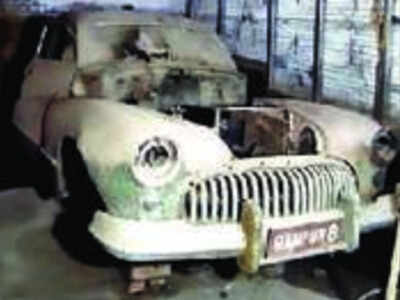
RAMPUR: Plymouth (1957), Dodge convertible (1954), Austin convertible (1956), Buick (1939), Jeep Willys (1956), Fiat (1956) and Fargo trucks – the Rampur royals’ Khasbagh Palace has now unravelled a set of royal beauties on wheels that is any collector’s dream.
Eight months after the Supreme Court passed judgment for the division of the property among the family members of the erstwhile Rampur Nawab in July 2019, the district administration is evaluating the moveable and immoveable properties of the erstwhile royals.
The garage of Khasbagh Palace was unlocked amid tight security recently.
After this, there are four more palaces to be opened and an inventory is to be made of its valuables.
Court-appointed commissioner Saurabh Saxena said, “We will be consulting the cars’ foreign manufacturers before evaluation them."
Kashif Khan, spokesman of Kazim Ali Khan, one of the 16 claimants of the royal properties, told TOI, “All these 20 cars were imported from European countries as well as the US. They have been lying in the garage since 1972 when the litigation started. Kazim Ali Khan plans to restore these cars to their early glory and send them to vintage car rallies following distribution of all the properties.”
Saleem Khan, 77, who was appointed superintendent of Khasbagh Palace in the sixties and still retains the post, said, “Sir Raza Ali Khan, who was the Nawab of Rampur from 1930 to 1966, was very fond of his Austin and Plymouth. They carried specialized registration numbers in gold on red number plates. When the Nawab’s cars were on road, all the traffic was blocked. Even trains were put on halt and crossing gates were not closed. Visiting foreign dignitaries and diplomats often enjoyed rides in these cars along with royal family members.”
According to Saleem Khan, former Rampur rulers travelled in their own luxurious railway saloons which are now parked at Nawab Rampur railway station, a private station the erstwhile royals built for themselves and which still stands just behind the present-day Rampur Junction. The private railway station is also one of the properties to be evaluated and distributed.
While deciding one of India’s longest running civil suits, which the SC finally brought to a close after 47 years of trial in July 2019, bench of then Chief Justice Ranjan Gogoi and Justices Deepak Gupta and Aniruddha Bose held the princely rule of primogeniture (the right of succession belonging to the firstborn child) will not apply in the succession of the private properties of a former ruler.
The bench also ordered that the properties of the erstwhile ruler of Rampur would be divided by metes and bounds among his successors as per the Muslim law.
It directed the District Judge of Rampur to appoint a commissioner to ensure division of movable and immovable properties among the successors.
Rampur State, a 15 gun-salute princely state, was founded in 1775 by Nawab Faizullah Khan. The Rampur Nawabs gave refuge to some of the literary figures from the court of Bahadur Shah Zafar, including Mirza Ghalib.
The Nawabs of Rampur sided with the British during Indian Rebellion of 1857 and this enabled them to continue to play a role in the social, political and cultural life of Northern India.
Eight months after the Supreme Court passed judgment for the division of the property among the family members of the erstwhile Rampur Nawab in July 2019, the district administration is evaluating the moveable and immoveable properties of the erstwhile royals.
The garage of Khasbagh Palace was unlocked amid tight security recently.
After this, there are four more palaces to be opened and an inventory is to be made of its valuables.
Court-appointed commissioner Saurabh Saxena said, “We will be consulting the cars’ foreign manufacturers before evaluation them."
Kashif Khan, spokesman of Kazim Ali Khan, one of the 16 claimants of the royal properties, told TOI, “All these 20 cars were imported from European countries as well as the US. They have been lying in the garage since 1972 when the litigation started. Kazim Ali Khan plans to restore these cars to their early glory and send them to vintage car rallies following distribution of all the properties.”
Saleem Khan, 77, who was appointed superintendent of Khasbagh Palace in the sixties and still retains the post, said, “Sir Raza Ali Khan, who was the Nawab of Rampur from 1930 to 1966, was very fond of his Austin and Plymouth. They carried specialized registration numbers in gold on red number plates. When the Nawab’s cars were on road, all the traffic was blocked. Even trains were put on halt and crossing gates were not closed. Visiting foreign dignitaries and diplomats often enjoyed rides in these cars along with royal family members.”
According to Saleem Khan, former Rampur rulers travelled in their own luxurious railway saloons which are now parked at Nawab Rampur railway station, a private station the erstwhile royals built for themselves and which still stands just behind the present-day Rampur Junction. The private railway station is also one of the properties to be evaluated and distributed.
While deciding one of India’s longest running civil suits, which the SC finally brought to a close after 47 years of trial in July 2019, bench of then Chief Justice Ranjan Gogoi and Justices Deepak Gupta and Aniruddha Bose held the princely rule of primogeniture (the right of succession belonging to the firstborn child) will not apply in the succession of the private properties of a former ruler.
The bench also ordered that the properties of the erstwhile ruler of Rampur would be divided by metes and bounds among his successors as per the Muslim law.
It directed the District Judge of Rampur to appoint a commissioner to ensure division of movable and immovable properties among the successors.
Rampur State, a 15 gun-salute princely state, was founded in 1775 by Nawab Faizullah Khan. The Rampur Nawabs gave refuge to some of the literary figures from the court of Bahadur Shah Zafar, including Mirza Ghalib.
The Nawabs of Rampur sided with the British during Indian Rebellion of 1857 and this enabled them to continue to play a role in the social, political and cultural life of Northern India.
Trending Topics
LATEST VIDEOS
City
 Bhuj sect's Swami stirs controversy, says 'If menstruating women cook food, they will be born as bitch in next life'
Bhuj sect's Swami stirs controversy, says 'If menstruating women cook food, they will be born as bitch in next life'  30 kg gold looted in Ludhiana, robbers caught on camera
30 kg gold looted in Ludhiana, robbers caught on camera  Jamia student files case against Delhi police, seek Rs 1 crore as compensation
Jamia student files case against Delhi police, seek Rs 1 crore as compensation  Mangaluru restaurant offers complementary biryani to blood donors
Mangaluru restaurant offers complementary biryani to blood donors
More from TOI
Navbharat Times
Featured Today in Travel
Get the app



